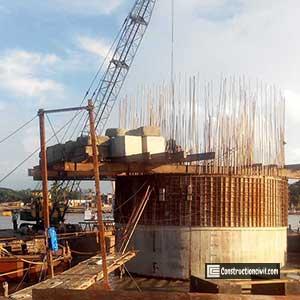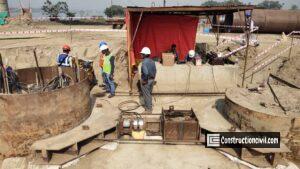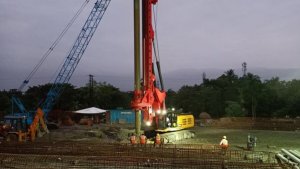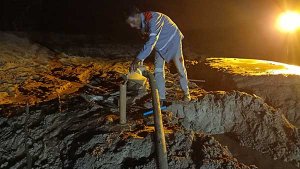Well sinking is done in two different ways open sinking and pneumatic sinking. When open sinking does not help much due to hard strata pneumatic well sinking may be adopted. Well sinking operation involves lowering of well by dredging in the dredge hole with the help of plate grab in the case of soft strata like sandy silt, soft clay, sandy clay, dense sand etc. Levels and alignment of well shall be checked periodically at every 0.5m of sinking. Well Sinking operation shall preferably be non-stop under skilled supervision.
Also, Read: Construction of Well Foundation – Step by Step Procedure
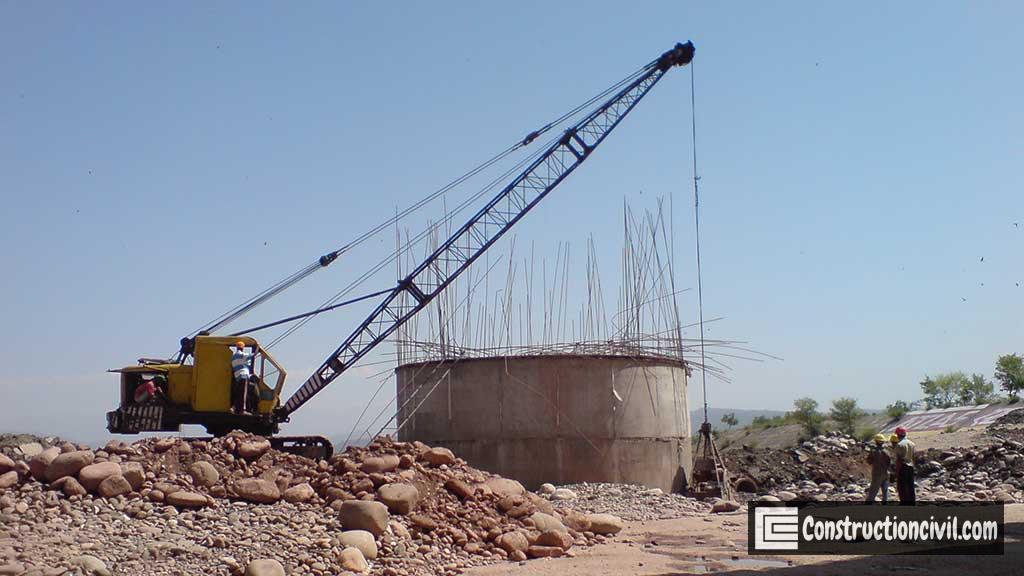
Well Sinking Through Stiff Clay Strata:
- If a stiff clay layer is encountered during the well sinking, a very tough and challenging situation is faced.
- The well becomes stationary and does not move at all.
- The well may start tilting due to the action of horizontal water current force.
- It may lead to an expensive and time-consuming affair for attempting to make the well straight and vertical.
Well Sinking Measures:
- Remove soil in contact with the outer surface by grabbing to a certain depth.
- Continue grabbing much below the cutting edge level.
- Dewatering inside dredge hole to a certain depth for reducing buoyancy and thereby increasing self-weight effectively.
- Flushing water jet to soil outside through holes kept in well steining.
- Kentledge loading may be applied on well.
- Thumping on water inside the dredge hole by grab.
Sinking of Well Through Boulder Strata:
- If Boulders are lying in loose condition, then by standard grabbing and chiselling is suitable.
- If they are cemented but not very firmly, then by underwater blasting is effective by sending experienced divers.
- If they are cemented very firmly, pneumatic sinking may have resorted to Alternatively.
- Drilling through holes kept in steining and bottom plug and by anchoring.

Also, Read: Construction of Footings – Important Guidelines
Formation of Heaves in the Dredge Holes:
- When a well passes through soft strata over a considerable depth, the upward resistance acting on the outside surface of the well is less than the weight of the well. In that situation, the well sinks down and quite often a heap is formed inside the dredge hole.
- Problem is acute when such situation happens when the well has reached its design depth since the bottom plug cannot be done without some sump.
Well Sinking Measures::
- Stop well sinking for a few days, and after the construction of false steining sinking of well may be continued.
Sand Blowing:
- The problem occurs when well bottom rests on sandy strata, and uncontrolled dewatering is done.
- The sand from outside gushes inside dredge hole, and there is the sudden sinking of well.
- This sudden well sinking is very dangerous, and the well may crack and which is very difficult to repair.
- If sand blowing is on one side of the well, tilt will take place.
Well Sinking Measures:
- A large number of sandbags are heaped outside the well steining.
- Scrap gunny bags and branches of trees full of green leaves are thrown into the funnel.
- Grabbing and pumping of water are continued inside the dredge hole.
Tilt and Shift in Well Foundation:
Precautions during Well Sinking operation:
- The number of wells to be taken up in one season shall be so planned that all the wells could be sunk to sufficient depth below design scour level before the onset of the flood.
- The sinking operations should be carried on with great caution whenever cutting edge approaches the junction of different type of strata.
- The controlled sump shall be maintained below the well curb to avoid sudden and excessive sinking of well.
- Dewatering shall not be permitted as a means for well sinking to prevent sand blowing.
- Sand blowing may be minimized by pumping water inside the dredge hole and keeping the inside water higher than outside or by adding heavy kentledge.
- For abutment wells having a high bank on one side of the well, sufficiently large-sized pit shall be excavated leaving about 6.0m-8.0m clear distance around the well.
- In soft strata prone to settlement, construction of abutment well shall be taken up only after the approach embankment for a sufficient distance near abutment has been completed.
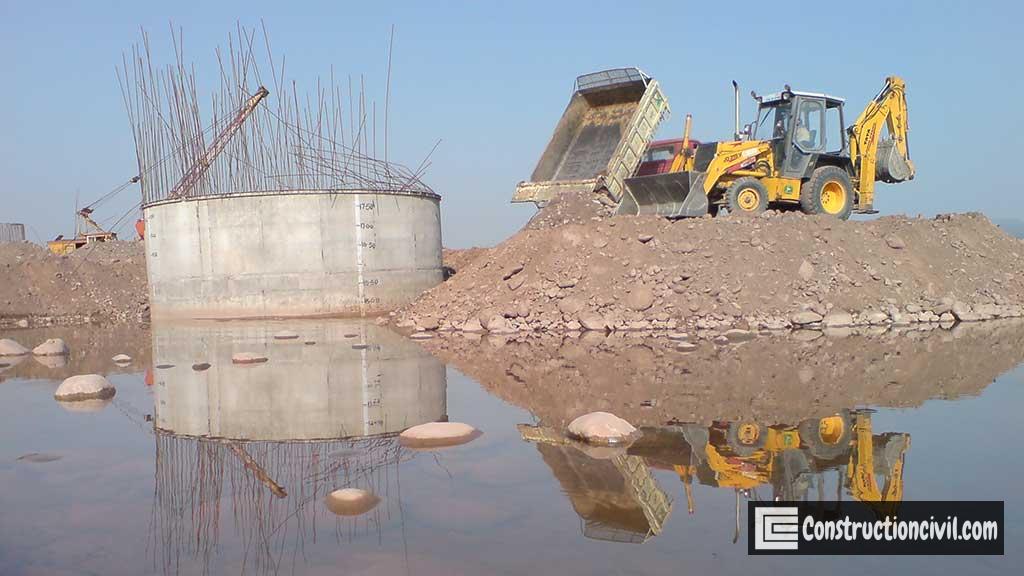
Also, Read: Types of Deep Foundation in Civil Engineering
Causes of Tilt and Shift in Well Foundation:
- Non-uniform bearing capacity
- Obstruction on one side of well
- Sand blowing in well during sinking causing sudden sinking
- Deposition of dredged material on one side of well causing unequal earth pressure
- Sudden sinking due to blasting
- The irregular casting of well steining causing the difference in skin friction
- Inadequate care in well sinking at the change of soil strata
Precautions to Minimize Tilt and Shift in Well Foundation:
- The wells shall be sunk into earth within the permissible limit of tilt and shift, which are 1 (horizontal) in 80 (vertical) and 150mm respectively.
- The dredging shall be done uniformly over the dredge hole area.
- Correction of minor tilt and/or shift can be achieved by controlled differential grabbing/ dredging.
Rectification of Tilt and Shift in Well Foundation:
- When tilt and/or shift are more, the following methods are adopted
- Eccentric grabbing
- Eccentric Kentledge loading
- Providing temporary obstacles beneath cutting edge
- Eccentric chiselling
- Depositing grabbed materials on one side
- Pulling/pushing the well by winches/jacks
- Water Jetting
- Strutting the well
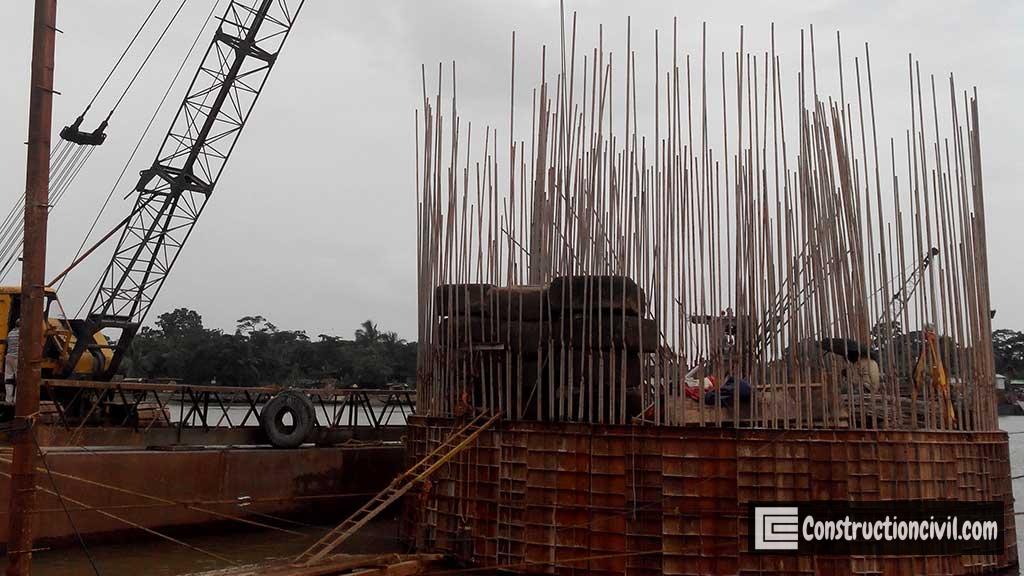
Monitoring Tilt and Shift in Well Foundation:
- Tilt and shift are monitored by checking the levels at fixed gauge mark on both of the opposite faces along the axis of the well.
- Levels are checked from the reference pillars along the axes established in advance
- The difference in level is the tilt along the axis
- It is designated as the ratio of the difference in level to the diameter of well.
- Checking of tilts and shifts shall be done at regular intervals depending upon the rate of sinking but at least once a day on the date of sinking operation.
- Recording of tilt and shift shall be maintained in the format given in Appendix 1200/II of MoRTH Specification.
Also, Read: What is Well Foundation? – Types & Components of Well Foundation
